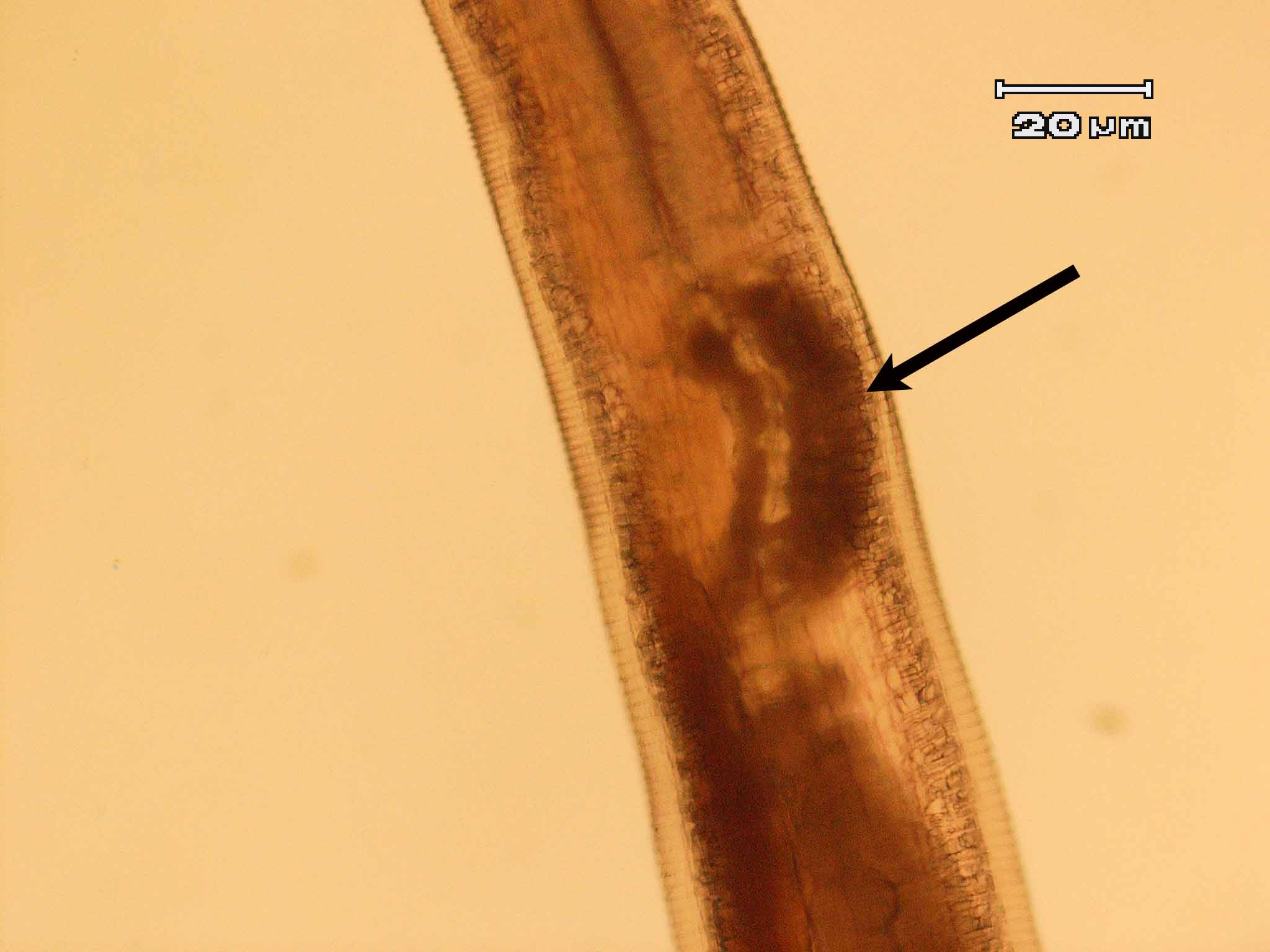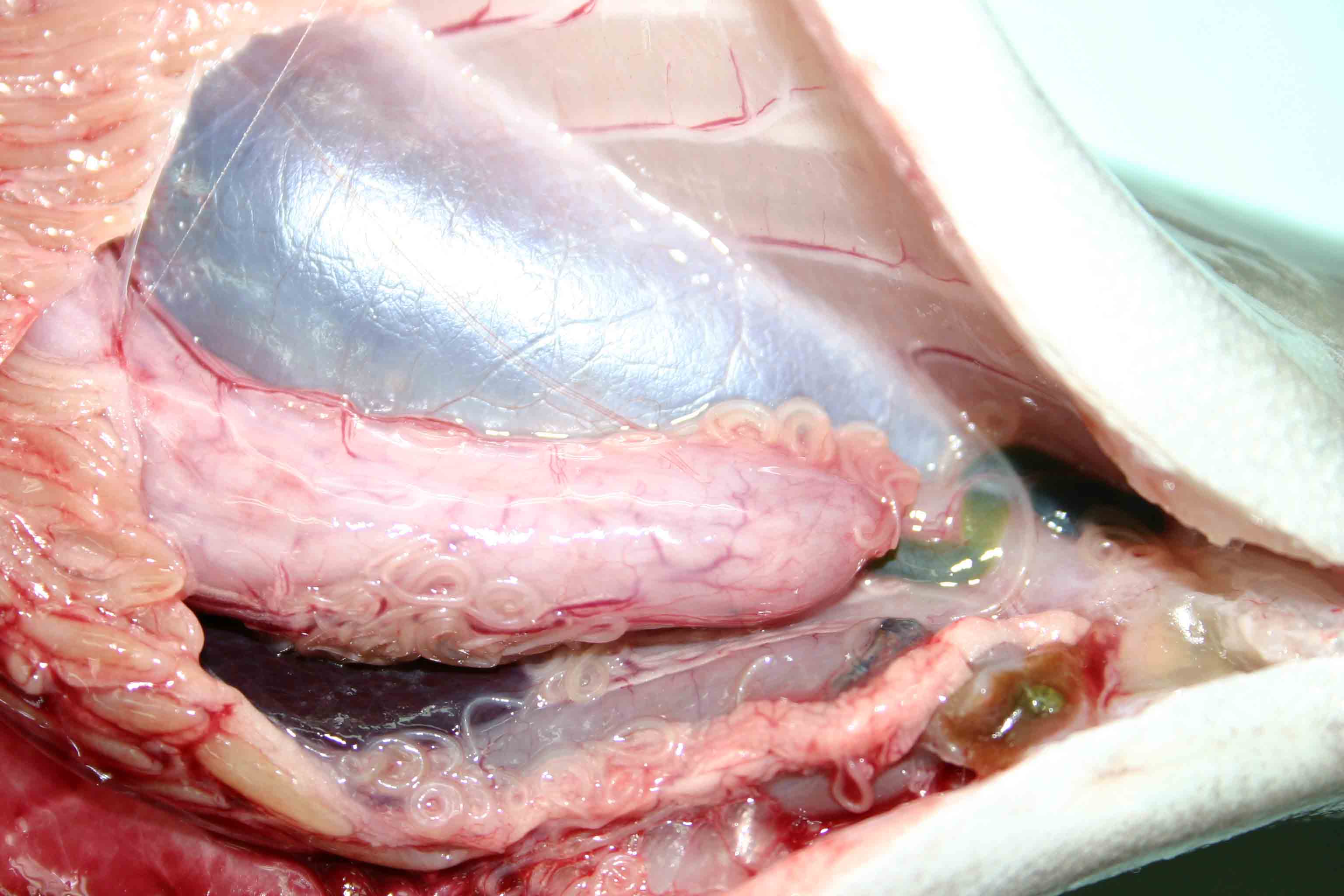
| 寄生虫名 | Anisakis pegreffii(アニサキス・ペグレッフィ) |
|---|---|
| 分類学 | 線形動物門、双線綱、アニサキス科 |
| 宿主名 | カンパチ(Seriola dumerili)、イサキ(Parapristipoma trilineatum)、マサバ(Scomber japonicus)、ゴマサバ(Scomber australasicus)他多くの海産魚 |
| 寄生部位 | 腹腔内、内臓、まれに筋肉 |
| 肉眼所見 | 外観的な異常は見られない。解剖すると、大きさ1-3 cm程度の糸状の虫体が腹腔内、肝臓、胃壁の表面等から、とぐろを巻いた状態で見つかる(写真1)。魚種によっては筋肉に寄生することもある。 |
| 寄生虫学 | 終宿主は主に鯨類であり、その胃の中で成虫となり産卵する。その後、海中に放出された虫卵から孵化した幼虫は、オキアミなどの甲殻類に捕食され、さらにそれを摂取した魚介類に寄生する。なお、アニサキス症を引き起こすAnisakis I型幼虫は、かつてはA. simplexの3期幼虫であると考えられていたが、現在ではA. simplexの他にA. simplex C、A. pegreffii、A. typica、A. ziphidarumの3期幼虫も含むことが知られている(Mattiucchi et al., 2002)。また、狭義(sensu stricto)にA. simplexといった場合には1種をさすが、広義(sensu lato)にはA. simplex CとA. pegreffiiも含む。 |
| 病理学 | 魚への病害性は低いと考えられるが、本虫が大量寄生したカンパチでは、胃が変形する等の病理変化が報告されている(Yoshinaga et al., 2006)。 |
| 人体に対する影響 | アニサキス症の原因となる。生きた虫体を摂取すると、寄生虫が胃腸壁に穿孔して激しい腹痛、嘔吐伴う急性胃腸炎を引き起こす。を引き起こす。そのため、A. pegreffiiが寄生しうる魚介類を生食する場合は注意が必要である。加熱処理や-20℃で24時間以上冷凍すれば虫体は死滅する。 |
| 診断法 | Anisakis I型の3期幼虫は、頭端に穿孔歯を持つ。食道に続いて単純で比較的長い食道胃部は存在するが、腸盲嚢はない。尾部が鈍端に終わり尾小棘を有する点でAnisakis II型幼虫と区別できる(小山, 1974)。A. simplexとの相違は胃の長さにあるが(写真2)、形態のみに基づいて分類することは容易でない。そこで現在では、リボソームRNA遺伝子等の塩基配列や制限酵素断片長の多型などを利用して識別されている(Abe et al., 2006; Valentini et al., 2006; Umehara, et al., 2006)。 |
| その他の情報 | 基本的に天然魚の寄生虫であるが、2005年に中国から養殖種苗として輸入されたカンパチとイサキの幼魚に、本虫と考えられるAnisakis I型幼虫が高頻度で寄生しており問題となった。これらの種苗は、中国での育成中に生餌として本虫が感染した魚を与えられたために寄生を受けたと考えられている(Yoshinaga et al., 2006)。 |
| 参考文献 | Abe, N., K. Tominaga
and I. Kimata (2006): Usefulness of PCR-Restriction Fragment Length
Polymorphism Analysis of the Internal Transcribed Spacer Region of rDNA for
Identification of Anisakis simplex
Complex. Japan. J. Infect. Dis., 59, 60-62.
小山 力 (1974): I. アニサキス亜科幼虫, 1. 形態・分類. 魚類とアニサキス(日本水産学会編),恒星社厚生閣, pp.9-19. Mattiucci, S., L. Paggi, G. Nascetti, C. P. Santos, G. Costa, A. P. Di Beneditto, R. Ramos, M. Argyrou, R. Cianchi and L. Bullini (2002): Genetic markers in the study of Anisakis typica (Diesing, 1860): larval identification and genetic relationships with other species of Anisakis Dujardin, 1845 (Nematoda: Anisakidae). System. Parasitol., 51, 159-170. Umehara, A., Y. Kawakami, T. Matsui, J. Araki and A. Uchida (2006): Molecular identification of Anisakis simplex sensu stricto and Anisakis pegreffii (Nematoda : Anisakidae) from fish and cetacean in Japanese waters. Prasitol. Int., 55, 267-271. Valentini, A., S. Mattiucci, P. Bondanelli, S. C. Webb, A. A. Mignucci-Giannone, M. M. Colom-Llavina and G. Nascetti (2006): Genetic relationships among Anisakis species (Nematoda: Anisakidae) inferred from mitochondrial COX2 sequences, and comparison with allozyme data. J. Parasitol., 92, 156-166. Yoshinaga, T., R. Kinami, K. A. Hall and K. Ogawa (2006): A preliminary study on the infection of Anisakid larvae in juvenile greater amberjack Seriolae dumerili imported from China to Japan as mariculture seedlings. Fish Pathol., 41, 123-126. |
(写真提供者:良永知義(1)、カール・マルクス・キアゾン(2))

または


写真1.中国産カンパチに寄生していたAnisakis pegreffi
写真2.Anisakis pegreffi の胃(矢印)。A. simplexと比べて、
顕著に短い。